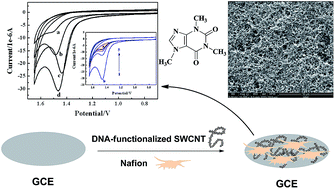Sensitive voltammetric detection of caffeine in tea and other beverages based on a DNA-functionalized single-walled carbon nanotube modified glassy carbon electrode†
Abstract
A simple and sensitive electrochemical method, based on a DNA-functionalized single walled carbon nanotube (DNA-SWCNT) and Nafion composite film modified glassy carbon electrode, was proposed to determine caffeine. The electrochemical behavior of caffeine at the modified electrode was investigated by cyclic voltammetry (CV), chronocoulometry (CC) and chronoamperometry (CA), and the results reveal that the DNA-SWCNT and Nafion composite film can remarkably enhance the electro-oxidation signal of caffeine. Moreover, the dependence of the current on pH, the nature of the buffer, instrumental parameters, accumulation time and potential were investigated to optimize the experimental conditions for the determination of caffeine. Under the selected conditions, the oxidation peak current of caffeine was proportional to its concentration in the range of 2.0 × 10−8 to 1.5 × 10−6 mol L−1, with a detection limit of 8.0 × 10−9 mol L−1. The developed method showed excellent selectivity, good stability and repeatability. The fabricated electrode was also used to determine caffeine in tea and other beverages with acceptable recovery.


 Please wait while we load your content...
Please wait while we load your content...